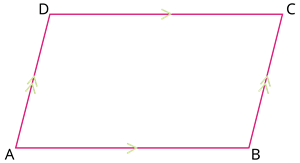
PUMPA - SMART LEARNING
எங்கள் ஆசிரியர்களுடன் 1-ஆன்-1 ஆலோசனை நேரத்தைப் பெறுங்கள். டாப்பர் ஆவதற்கு நாங்கள் பயிற்சி அளிப்போம்
Book Free DemoParallelogram:
A parallelogram is a quadrilateral (four-sided figure) in which the opposite sides are parallel.

In the figure, the side \(AB\) is parallel to \(CD\), and \(AD\) is parallel to \(BC\).
Important!
• The opposite sides are congruent.
• The two diagonals bisect each other.
• The opposite angles are congruent.
• The consecutive angles are supplementary.
Area of the parallelogram:
The area of any parallelogram is calculated using the formula \(A = b \times h\) square units.
Where \(h\) represents the height of the parallelogram and \(b\) represents the base of the parallelogram.
Example:
If the height and the base of the parallelogram are \(12\) \(cm\) and \(6\) \(cm\), then find its area.
Solution:
Given \(h\) \(=\) \(12\) \(cm\) and \(b\) \(=\) \(6\) \(cm\).
Area of the parallelogram, \(A\) \(=\) \(b \times h\)
\(=\) \(12 \times 6\)
\(=\) \(72\) \(cm^2\)
Ways to construct a parallelogram:
A parallelogram can be constructed if one of the following four measurements are given.
(i) Two adjacent sides and one angle.
(ii) Two adjacent sides and one diagonal.
(iii) Two diagonals and one included angle.
(iv) One side, one diagonal and one angle.